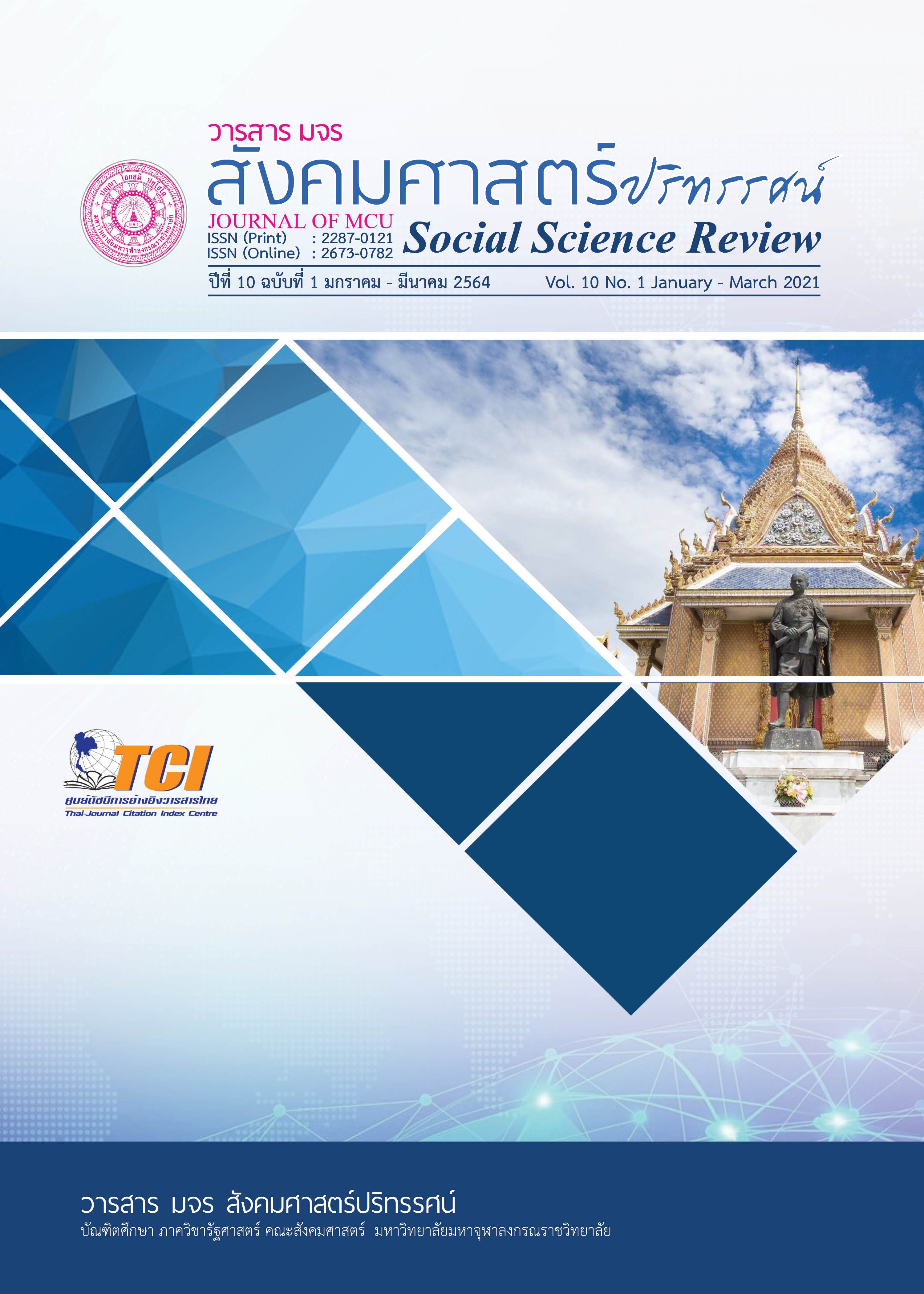A MODEL OF BUDDHIST CONSTRUCTION MANAGEMENT ACCORDING TO MONASTERY, PEOPLE AND STATE FOR HAPPINESS CREATION PROJECT OF SANGHA ADMINISTRATION, PATHUMTHANI PROVINCE
Keywords:
Management, Buddhist Construction, Monastery, People and State for Happiness Creation ProjectAbstract
Objectives of this research were to study general condition, development components and propose a model. Methodology was the qualitative research; data were collected from 25 key informants by in-depth-interview and from 10 participants in focus group discussion. Data were analyzed by systematic descriptive interpretation. Findings were as follows: 1. This project was the important policy of Sangha. There was committee appointment to move the project. 2. Components consisted of 1) committee appointment, 2) policy announcement, 3) training for knowledge, 4) survey of the responsible areas, 5) improvement plan setting, 6) kick off ceremony, 7) big cleaning days and 7) area assessment. 3. The model consisted of 4 models: 1) Planning model; planning for monastery Buddhist construction development according to Buddhist affairs reform strategies and Buddhist construction policy of Supreme Patriarch in line with community virtue to practice along with the sufficiency economy philosophy. Pathumthani Province is read to development human resource to be intelligent and good citizens of the country in the future. 2) Operation model; operation of the project with the big cleaning days and conducting development management in 9 areas, 3) Checking model; evaluation and assessment of the monastery, people and state for happiness creation project according to plan. Assessment according to set plan, analyzing problems and causes of problems, comparing the target with operation plan to find out the pitfall to improve. Evaluation helped know the present condition of the operation by comparing with plan and 4) improvement model; evaluation according to the set plan, etc.
References
กองแผนงาน. (2554). คู่มือพระสังฆาธิการ. กรุงเทพฯ: โรงพิมพ์สำนักงานพระพุทธศาสนาแห่งชาติ.
กองพุทธศาสนสถาน กรมการศาสนา. (2545). คู่มือการพัฒนาวัด อุทยานการศึกษาในวัดลานวัด ลานใจ ลานกีฬา. กรุงเทพฯ: โรงพิมพ์การศาสนา.
คณะสงฆ์จังหวัดปทุมธานี. (2561). คู่มือและกรณีศึกษาการดำเนินงานโครงการฯ. ปทุมธานี: คณะสงฆ์จังหวัดปฐมธานี.
พระครูวัชรสุวรรณาทร ธมฺมโชโต (ลูกชุบ เกตุเขียว). (2558). การประยุกต์ใช้อิทธิบาทธรรมเพื่อส่งเสริมกลยุทธ์การอนุรักษ์โบราณสถานของพระสังฆาธิการในเขตปกครองคณะสงฆ์ภาค 15 (วิทยานิพนธ์ปริญญาพุทธศาสตรดุษฎีบัณฑิต สาขาวิชาการจัดการเชิงพุทธ). พระนครศรีอยุธยา: มหาวิทยาลัยมหาจุฬาลงกรณราชวิทยาลัย.
พระครูวินัยธรธรรมภณ ธมฺมพโล (แก้วแจ่มศรี). (2558). การพัฒนาการจัดการศาสนสมบัติของวัดในจังหวัดพระนครศรีอยุธยา (วิทยานิพนธ์ปริญญาพุทธศาสตรดุษฎีบัณฑิต สาขาวิชาการจัดการเชิงพุทธ). พระนครศรีอยุธยา: มหาวิทยาลัยมหาจุฬาลงกรณราชวิทยาลัย.
พระครูวิสิฐพัชราจาร (ไชยยา เขมสิริ). (2558). การพัฒนาการจัดการสาธารณูปการของพระสังฆาธิการจังหวัดเพชรบุรี (วิทยานิพนธ์ปริญญาพุทธศาสตรดุษฎีบัณฑิต สาขาวิชาการจัดการเชิงพุทธ). พระนครศรีอยุธยา: มหาวิทยาลัยมหาจุฬาลงกรณราชวิทยาลัย.
พระครูอุทัยกิจจารักษ์ (สุรางค์ สุจิณฺโณ). (2557). รูปแบบการบริหารจัดการเผยแผ่พระพุทธศาสนาขององค์กรปกครองคณะสงฆ์ ภาค 2 (วิทยานิพนธ์ปริญญาพุทธศาสตรดุษฎีบัณฑิต สาขาวิชาการจัดการเชิงพุทธ). พระนครศรีอยุธยา: มหาวิทยาลัยมหาจุฬาลงกรณราชวิทยาลัย.
พระธรรมปริยัติโสภณ (วรวิทย์ คงฺคปญฺโญ). (2553). การพัฒนาพระสังฆาธิการภาค 2 ภาคปฏิบัติการ. กรุงเทพฯ: โรงพิมพ์มหาจุฬาลงกรณราชวิทยาลัย.
เรวัตร์ ชาตรีวิศิษฏ์. (2550). ทฤษฏีกิจกรรม 5 ส ให้สัมฤทธิ์ผลนั้นมาจากคน. กรุงเทพฯ : สำนักพิมพ์ศูนย์ส่งเสริมวิชาการ.
สำนักงานพระพุทธศาสนาแห่งชาติ. (2553). วัดพัฒนาตัวอย่าง. กรุงเทพฯ: โรงพิมพ์สำนักงานพระพุทธศาสนา.
สุรพล สุยะพรหม และคณะ. (2555). พื้นฐานทางการจัดการ. กรุงเทพฯ: โรงพิมพ์มหาวิทยาลัยจุฬาลงกรณราชวิทยาลัย.
Downloads
Published
How to Cite
Issue
Section
License
Copyright (c) 2021 Journal of MCU Social Science Review

This work is licensed under a Creative Commons Attribution-NonCommercial-NoDerivatives 4.0 International License.
In order to conform the copyright law, all article authors must sign the consignment agreement to transfer the copyright to the Journal including the finally revised original articles. Besides, the article authors must declare that the articles will be printed in only the Journal of MCU Journal of Social Sciences. If there are pictures, tables or contents that were printed before, the article authors must receive permission from the authors in writing and show the evidence to the editor before the article is printed. If it does not conform to the set criteria, the editor will remove the article from the Journal without any exceptions.





